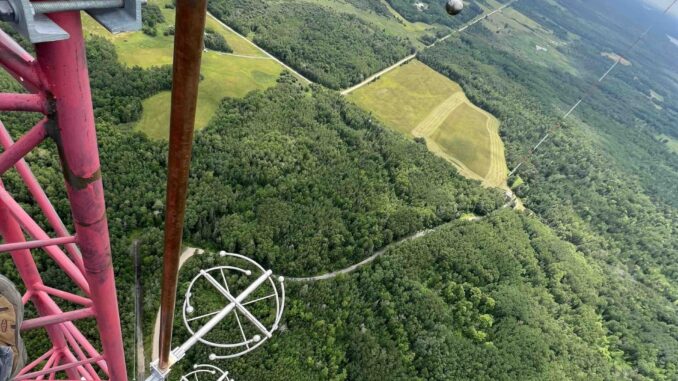
Six months into their US partnership, Dielectric and SCMS have developed a rapport that has opened Dielectric to a growing number of FM projects in the domestic radio market. Minnesota Public Radio is among the first broadcasters to benefit with the installation of a 12-bay antenna and a combiner in the northern reaches of the state, with the new partners working together to meet specific delivery timelines.
SCMS’s close relationship with the customer laid the initial groundwork, bringing the opportunity to Dielectric as details of the antenna replacement project emerged. Within weeks, Dielectric moved into the design phase to quickly bring a new DCR-M ring-style antenna system to life for KNBJ-FM and KCRB-FM serving the Bemidji market. The Dielectric antennas were built and delivered with a shorter than standard lead time as the existing antenna, in service for more than 30 years, showed signs that end of life was fast approaching.
Minnesota Public Radio transitioned to its new Dielectric antenna system in July, with immediate improvements to RF efficiency and performance. Notable improvements include corrections to an escalating reflected power issue that affected transmitter performance, and the stability to maintain higher sideband levels that better support HD Radio signals.
Dielectric also produced the ring-style system with the tower’s weight restrictions in mind, opting for a dual center-fed design to maximize bandwidth and reduce the effects that ice buildup creates — a critical requirement as the addition of radomes would exceed the weight threshold.
“Northern Minnesota is among the harshest outdoor environments in the continental United States, and the effects of many long winters had finally caught up,” said Vincent Fuhs, Manager, Network Engineering Group, Minnesota Public Radio. “That included large cracks and moisture infiltration from icing damage, raising VSWR levels to the point where reflected power became a concern. The transition to a modernized antenna system eliminates RF concerns like these that emerge over time, while also opening new possibilities such as raising our HD Radio insertion levels from -20 to -14dBc. The DCR-M design offers the amount of bandwidth we need to maintain the improved HD Radio power that comes with that 6dB sideband increase, which makes HD Radio programming more accessible through the market.”
Dielectric also built a new combining system to keep signals from mixing as they exit the transmitter and begin their journey up the tower. The patented Manifold design includes two distinct space-saving sections, each taking in one station’s on-frequency signal and merging them for carriage through the transmission line and the DCR-M system. On arrival, the 12-bay DCR-M system, positioned at just over 1000 feet in altitude, combines the two frequencies radiating the KNBJ’s 65kW and KCRB’s 83kW ERP signals.
Fuhs adds that both Dielectric and SCMS have always provided excellent support, and Dielectric’s thoughtful approach to engineering addressed his concerns around weight and icing protection. SCMS Regional Sales Representative Andy Cole, who has a 20-year business relationship with Fuhs, was responsible for bringing Dielectric into the project.
“With the lack of radomes in mind, Dielectric went down the path of a dual center-fed solution with separate upper and lower sections,” said Fuhs. “Due to our harsh environment the antenna bays, having structural reinforcement, should make them more robust in the winter months. We anticipate that design will pay off through many long winters to come.”
